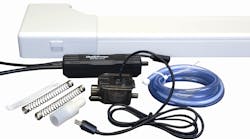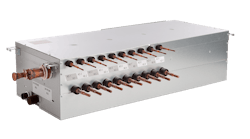By Ron Zimmer
The world of building controls is changing in ways that will benefit both HVAC contractors and the customers they serve.
Integration of building systems allows controls contractors to offer owners and managers more energy efficient buildings than ever before. Meanwhile, advancements in wireless technology are helping contractors solve difficult controls challenges in retrofit projects.
However, it is incumbent upon you, the contractor, to ensure that customers are educated about the value available to them. There’s a constant need to be educated in terms of products that are in the marketplace, and knowledgeable about the opportunities to work more closely with customers and educate them to the value of the products and systems that are in their buildings.
Integrated Systems
Not every building needs leading edge technology when it comes to building integration. There are many stand-alone systems and products that are very practical and reasonable for a wide range of situations.
However, the flip side of that coin is that there are many situations where people are not taking advantage of integrated systems. These systems can increase for building owners and managers the value of their building, employee or tenant retention, and improve working conditions, security, and communication ability. All of these reduce your customers’ overall costs and increase their profits.
For many building owners, high energy costs are driving greater interest in building controls. Your customers need to understand that while there may be some higher initial costs associated with a high quality energy management system, energy reductions of 30 to 50% are very real, very long-term, and very bottom line for the owner/operator or manager of a large facility.
And that’s just one system. Let the energy management systems you can offer be the opening in the door you need to sit down with and explain all that a great controls and systems integration company can offer.
Communicate to your clients the long-term value of integrated systems in terms of a building’s life cycle. An integrated system might (and I stress might) increase upfront costs, but over 20, 30, or 40 years of usage in a building, the positive effect on the owner’s bottom line is huge.
With your help, building owners and managers should ultimately view their buildings as a tremendous value, as a high form of equity, and as an asset, not a liability that is draining in terms of their profits. If you can convey that message — and deliver on it — you can really differentiate yourself in the marketplace.
Open Controls
Good news for controls contractors: the industry is increasingly moving more toward open systems instead of proprietary building controls. That’s not to say we’ll ever get away from proprietary systems, but there has been a major shift in the direction of helping you not be beholden to one company. That is really changing the landscape.
CABA has launched oBIX, the open building information exchange. We don’t write standards, but we work with many standard protocol bodies, and we’re driven as part of the mission of our organization to drive more open protocols. So, along with roughly 100 industry groups, we championed the oBIX initiative. That initiative now resides with OASIS, which is a group that does write industry standards.
That means we now have a standards-writing organization that is very active with some of the major players in the controls industry to help bring forward the use of extensible markup language (XML) as a controls platform. XML allows the exchange of information and data between some of the traditional protocols like LonMark and BACnet and proprietary standards. That’s a very positive movement forward.
The intent of oBIX is to bring forward a new data model that hopefully would be accepted by the industry and will help everyone create more of a mass market. BACNet is moving forward with a similar initiative, so we hope at some point to arrive at a situation where BACNet and LonMark systems are very compatible. We’re working very hard as an industry group to help people move together, which would benefit manufacturers, contractors, and end-users alike.
Wireless Technology
There have been huge steps forward taken in the wireless arena. We’re seeing wireless technology move forward in all markets: commercial, industrial, even residential. In the large building market, there have been major gains to overcome issues that have been prominent in the past with concrete floors and walls. And, as technology has improved, prices have dropped.
We often hear about the tremendous strides in the prevalence of leading edge building control usage being made in areas such as China and Dubai, as they are basically building major new cities from scratch. However, keep in mind that it’s always easier to make a new building leading edge.
Here in North America, we have a huge existing stock of commercial properties. Many of these have legacy systems that don’t make the best use of technology, and therefore don’t achieve anywhere near optimum energy efficiency. The challenges that have been posed by controls retrofits have been difficult to face, but wireless technology helps overcome many of them.
To sum up the state of the commercial controls industry, in many areas we’re taking steps forward — some small, some large. But regardless of their size, the steps are all forward, and ultimately the results will be very positive.
It’s a great time to be a controls contractor, if you make the effort to stay abreast of the technology and educate your customers.
TOOLS YOU CAN USE FROM CABA
Part of our role of the Continental Automated Buildings Association (CABA) is to help educate the marketplace. This means not just the engineers who are designing the systems, and the contractors who are installing them, but also end-users, architects, designers, facility managers, developers, and owners of large buildings. CABA wants them to understand the true life-cycle cost benefits of today’s integrated control systems. To that end, CABA is very close to unveiling a life-cycle cost-analysis tool that will help engineers and contractors explain the benefits of high-quality controls systems to their customers. It will be an online tool, available for a small fee, to all stakeholders to show the value of, for example, an energy management system.
More about CABA’s life-cycle cost analysis tool can be found at www.caba.org/councils/council.html.
CABA has also launched version two of its intelligent building technology roadmap. The first version is available free on www.caba.org/trm. This major research piece promises to be very valuable for the industry.
Finally, CABA has embarked on a new project that it’s calling the Building Intelligence Quotient (BIQ), an online tool that will allow users to rank intelligent buildings on a scale of 1 to100 based on the number of integrated systems it has. This will include the energy management systems. For more information about this tool, visit http://www.greenglobes.com/biq.
Ron Zimmer is president & CEO of the Continental Automated Building Association (CABA). CABA is based at the National Research Council in Ottawa, Ontario, Canada. Zimmer can be reached at [email protected]








